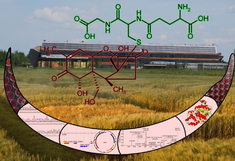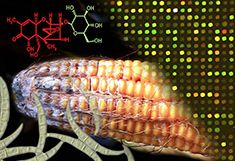SFB F37: Fusarium metabolites and detoxification reactions
Participants: 2009 - 2019
Gerhard Adam: Fungal Biochemistry and Genetics
Joseph Strauss: Fungal gene expression
Hans-Werner Mewes: Plant and Fungal Genomics
Rudolf Krska / Rainer Schuhmacher: Metabolomics
Hermann Buerstmayr: Plant Genetics
Participants: 2016 - 2019
Doris Marko: Toxicology of Fusarium toxins
Participants: 2009 - 2012
Eva Stöger: Wheat transformation
Marie-Theres Hauser: Arabidopsis ZON
Abstract SFB F37 Fusarium
Summary:
The fungus Fusarium graminearum infects worldwide crops of central importance such as corn and wheat, and contaminates by secreted toxins food and feed. The aim of the research of the SFB F37 is to utilize the rapidly advancing tools of genomics, transcriptomics and metabolomics to improve the understanding of the complex relationship between cereals and the broad host range fungal pathogen Fusarium graminearum.
Strategies:
Cereal plants and parasitic fungi are engaged in a race in which infection strategies of the fungi compete with plant resistance mechanisms. Fusarium graminearum exploits the effect of toxins to weaken plant cells and evade the immune system of the plant. Previous research showed a bitter feud between the plant and fungus including chemical attacks, detoxification and deception strategies. The SFB combines research groups with proven expertise in leading-edge biological fields. The aim is to use research on virulence mechanisms and to get this information to the breeding of resistant varieties. The exploration of the interaction mechanisms of the two organisms, will allow us to design interventions to tip the balance in favour of the crop.
Abstract SFB F37 Fusarium
Zusammenfassung:
Der Pilz Fusarium graminearum befällt weltweit zentrale Nutzpflanzen wie Mais und Getreide und kontaminiert durch ausgeschiedene Toxine Lebens- und Futtermittel. Ziel der Forschung des SFB F37 ist es die Infektion von Getreide durch Fusarium zu unterbinden.
Strategien:
Getreidepflanze und Pilz sind in einem Wettlauf in dem Infektionsstrategien und pflanzliche Resistenzmechanismen im Wettstreit liegen. Fusarium graminearum nutzt die Wirkung von Zellgiften in Form von Toxinen um Pflanzenzellen zu schwächen und die Abwehr der Pflanze zu umgehen. Bisherige Forschungen zeigten einen verbissenen Kleinkrieg zwischen Pflanze und Pilz mittels chemischen Angriffen, Entgiftungen und Täuschungsstrategien. Der SFB kombiniert Forschungsgruppen mit ausgewiesener Expertise in modernsten biologischen Gebieten. Ziel ist Virulenzmechanismen zu erforschen um diese Informationen zur Züchtung resistenter Sorten zu nützen. Wenn die Mechanismen beider Organismen aufgeklärt sind, kann in das Gleichgewicht zugunsten der Nutzpflanze eingegriffen werden.
Supported by the FWF



